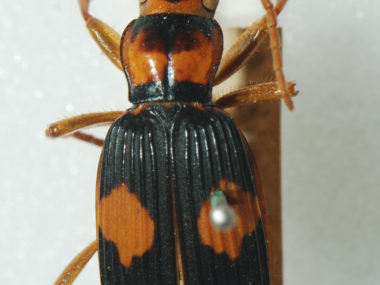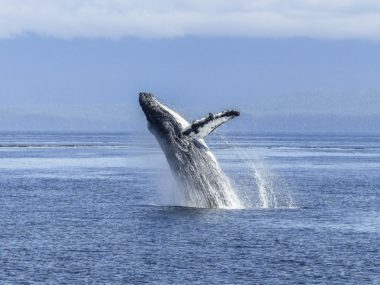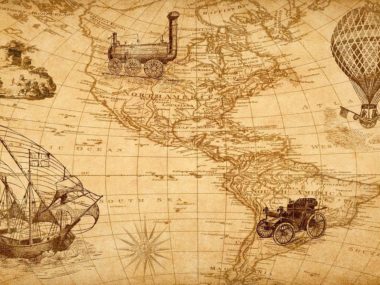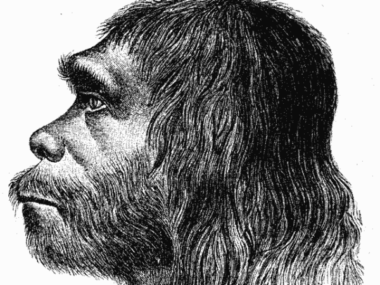The physical world does not seem to be inherently evil, such as the ancient Greeks believed. Nor, is the world in such conflict as naturalistic evolution would expect. Rather, the common and deep mutualisms suggest that the creation is basically good, perhaps not far removed from the label of ‘very good’ that the Creator originally gave it (Gen. 1:31). However, there is still something wrong with the biological world. Disease, death, and especially suffering do not seem to be expectations from the good God described in Scripture, so what is the origin of these things?
The following article is an excerpt from Devotional Biology: Learning to Worship the Creator of Organisms, Chapter 5.2 & 5.3 pgs. 108-114. The views expressed reflect those of the author, and not necessarily those of New Creation.
THE ORIGIN OF BIOLOGICAL EVIL
The immediate effect of Adam’s sin was his spiritual death (the dying referred to in Gen. 2:16-17). And, given Adam’s role as ruler, God responded to man’s sin by cursing man’s entire dominion. Wives became rebellious and husbands became abusive (Gen. 3:16b), human diet changed (Gen. 3:18), human childbirth became more painful (Gen. 3:16a), the human body became mortal (Gen. 3:19; Rom. 5:12), work became burdensome (Gen. 3:19), animals were cursed (Gen. 3:14a), plants were changed (Gen. 3:18), and the ground was cursed (Gen. 3:17).
The strong tie between human sin and animal death in the Bible’s sacrificial system suggests that human sin is not only the cause of human death, but also the cause of animal death. This would mean that before man’s sin, animals did not eat each other, which, in turn, is consistent with the original animals eating only plants (Gen. 1:30). And, since animals and humans are the only organisms that are biblically alive, it follows that all death is due to man’s sin. The original creation would have had no death of biblical life. Being ‘very good’ (Gen. 1:31), then, apparently not only means there was no death, but that the creation lacked suffering (excessive pain) and anything that would cause suffering. There would have been life without death, eating without predation, health without disease, maturation without deterioration. And, as the original creation was, the new heaven and new earth will be (Isa. 11:6-9; 65:17-25; Rev. 21:1-4).
In short, in the original creation there was no evil at all. There was neither moral evil (sin) nor natural evil (anything in the physical world that causes suffering). Consequently, there was no biological evil (anything in the biological world that causes suffering). There was no disease, and upon reaching maturity, humans and animals did not degenerate, nor did they die. All natural evil is part of God’s curse in response to man’s moral evil. This is consistent with the claims of Romans 8, that all created things are prone to aging, decay, and death (Rom. 8:20-21) and the entire creation will suffer (Rom. 8:22) until the curse is lifted with the final glorification of humans (Rom. 8:19; Rev. 21:3-4; 22:3).
Sin, in its essence, is due to a desire to be independent of God—to live outside of a relationship with God. When Adam sinned, he was choosing something other than a perfect relationship with God. God’s response was to curse all the relationships of the ruler’s dominion. Rather than each individual providing benefit to others, individuals began seeking their own benefit at the expense of others. Man seeks his own benefit rather than rely upon God. Wives try to rule over their husbands and husbands try to put down their wives. Men deal selfishly with other men, very soon after the Fall resulting in a man murdering his own brother (Gen. 4:4-8), and deteriorating thereafter to an earth filled with violence (Gen. 6:11).
The mutualistic relationship between the shepherd king and the animals of the world would change to include fear, subjection, and killing (Gen. 9:2-5). Relationships among animals changed as animals began eating other animals and deteriorating to a time when ‘all flesh had corrupted itself’ and the earth was ‘filled with violence’ (Gen. 6:12-13). Even the relationships between plants and the organisms that ate them changed (Gen. 3:18). Some of the changes occurred immediately at the curse; other changes developed over the years and centuries that followed.
NEGATIVE EFFECTS OF THE CURSE
Before the curse humans and animals were designed to live forever. If this was due to the design of the physical bodies of organisms, the processes that maintain physical bodies would have had to have been highly effective. All parts of all organisms would have to be kept in good, if not perfect, repair. Damaged, dying, or dead components would have to be detected and replaced quickly so that no tissue, organ, or organ system would fail or even degenerate.
This repair process would have to continue without diminishing. There would even have to be effective mechanisms for detecting and repairing damage to the information stored in DNA. Many of the negative effects of the curse may have been the result of God altering the efficiency of these repair processes. Just the slightest inefficiency would lead to the kinds of biological evils we see today.
Degenerative Aging. Once biological repair systems were unable to completely restore an organism, each component of the organism would become less and less efficient with time. Damage (e.g. mutations, chromosomal aberrations, injuries) would persist unrepaired. Each part would gradually wear out, and one organ after another would falter or fail. This is the cause of degenerative aging. Note, that this is not developmental aging, where an organism ‘grows up’ or matures. Developmental aging would have been a normal part of the world before the fall of man. What came as the result of the curse was degenerative aging, the type of aging that weakens an organism towards its death (that which leads to descriptions such as ‘over the hill’ and ‘growing old’).
Disease. Some of the unrepaired damage would be pathological (i.e. resulting in suffering, the word being derived from the Greek word pathos, meaning ‘suffering’). The breakdown in biological repair systems is likely to be the biological cause of most, if not all, pathogenesis—the ‘origin’ (Gr. genesis) of ‘suffering’ (Gr. pathos). Some of the damage causes harm (pathology or disease) directly to the altered organism (e.g. the mutation that causes sickle-celled anemia or the chromosomal aberration that causes Down’s syndrome).
Other damage does not so much hurt the altered organism directly, as much as it alters its relationships. In some of those relationships the organism becomes a pathogen—an organism that causes suffering in another organism. Examples would include the pathological varieties of the normally harmless anthrax bacteria found in soil, and the normally helpful E. coli found in our intestines. The fact that in most situations helpful varieties of microorganisms (such as E. coli) will outcompete the harmful varieties of the same species, suggests that pathology is due to deterioration of the design of the original biological system.
In fact, the breakdown of complex biological systems is likely to be how all diseases came to be, not only at the curse, but ever since then to the present day. For example, new mutations for sickle-celled anemia are thought to be occurring regularly in the human population.
Parasitism. Some of the unrepaired damage in organisms is likely to have introduced parasitism into the world. Parasitism is when one organism (the parasite) is benefited by harming another organism (the host). Examples include plants that parasitize other plants (e.g. mistletoe, Indian pipe, dodder), ticks that suck the blood of mammals, and lampreys that attach to and feed off of the bodies of other fish.
Some of the relationships between parasites and hosts are rather sophisticated. For example, ticks find mammal hosts by being attracted to higher temperatures and higher carbon dioxide levels. Many have pain killing chemicals in their saliva to avoid detection and an anticoagulant to prevent blood from clotting (e.g. leeches). Such sophisticated designs were probably part of an originally mutualistic relationship that became parasitic following the curse.
EVIL-MINIMIZING EFFECTS OF THE CURSE
The breakdown in efficiency of biological repair systems would be expected to gradually introduce more and more suffering into the biological world. God, however, did not wish suffering to be unlimited in this life. He wanted the horrible effects of sin to be felt, but He still desired that we would see His nature in those things He made (Rom. 8:20), including His mercy (e.g. Psa. 103:17), graciousness (e.g. Jonah 4:2), kindness (e.g. Psa. 36:7) and goodness (e.g. Psa. 119:68)a. Consequently, at the time of the curse God introduced things into the biological world that would put limits on how much biological evil would enter in the world.
Death. After the Fall, God drove Adam and Eve out of the Garden of Eden ‘lest they live forever’ (Gen. 3:22-24). Most likely, God prevented humans from living forever for our benefit. If degenerative aging had been introduced into the world, but animals and humans had not been permitted to die, then animals and humans would become feebler and feebler for eternity. If animals and humans were immortal in a world where suffering was increasing, then every individual would suffer more and more every day without limit. If humans remained physically immortal after dying spiritually, humans would remain separated from God forever, and increase in suffering without limit.
In the world before man sinned, death of man and animals would have been a bad thing. After man’s sin, death is a good thing.
Death is a consequence of sin and is the last enemy to be destroyed for the follower of Christ (1 Corinthians 15:26). However, in the cursed creation, God introduced physical death to nephesh life as an act of mercy. In a cursed world, the deaths of animals and humans places limits on the suffering and decay that occurs as a consequence of the curse. Also, human death permits people to be resurrected with perfect bodies. Death of nephesh life places limits on biological evil in a cursed creation, so its introduction at the time of the Fall was a good thing.
Competition and Natural Selection. As good as death might have been to put limits on suffering, the introduction of death created another problem. Before the Fall, every animal born would have survived to adulthood. To fulfill God’s command to ‘fill the earth’, populations would have increased until the earth was ‘full’ (i.e. carrying capacity had been reached). There were probably designs in place to cease reproduction in organisms when they reached the earth’s carrying capacity. Remnants of some of these controls on reproduction are seen in creatures whose reproductive rates are controlled by environmental factors (e.g. not enough food in the habitat or severe weather conditions may cause females not to produce young that year).
We do not know how fast God originally designed the world to be filled, but before man’s Fall it did not have to be quickly. After all, they had an eternity of time to do it! Consequently, animals before the Fall probably produced young at very low rates. Under such conditions today, the spread of a disease would run the risk of killing off animals faster than they could be replaced, thus bringing about the extinction of species. Even if an organism has already filled the earth and does not need to increase its numbers, it must produce more young to replace those that are dying. Consequently, God probably increased reproductive rates of all organisms over preFall levels. If the reproductive rates are raised high enough there are not enough resources available for every organism to survive—something called biological overproduction. Biological overproduction brings about competition, as organisms compete against other organisms to get the resources for themselves. Organisms must struggle to survive and some must die or move away for the population to survive. Biological overproduction sounds bad, and it would be in a world without death.
However, in a world with death, the weaker organisms will tend to be eliminated and the stronger ones will survive. Diseased individuals will tend to be taken out of the population, effectively slowing and in some cases preventing the spread of disease. If there are individuals in the population that are stronger or more disease-resistant and can genetically pass that information on to the next generation, those individuals will be ‘selected’ and the population will be improved in the process (something called natural selection).
In finch populations on the Galápagos Islands, for example, natural selection changes the size of finch beaks to match the size of plant seeds as climate changes alter the size of plant seeds. Competition and natural selection tend to reduce the total amount of disease in the world. Biological overproduction seems to minimize the total amount of biological evil in the world. Since biological overproduction is only a good thing in a world with death, it would have been a bad thing in the world before the curse. In a cursed world, however, biological overproduction places limits on biological evil, so its introduction as part of the curse was a good thing.
Predation. Another control on biological evil is predation. Predation is where some animals (predators) eat other animals (prey). As in the case of competition and natural selection, predators tend to take out the weaker individuals in a prey population. Consequently, predators tend to remove diseased organisms, slowing, stopping, or even eliminating disease in the prey population.
Studies have shown, for example, that when humans kill off wolves and other predators in a region, the deer populations in that region suffer from more disease than deer populations in areas with predators. To make sure that predation is most effective, predation designs were given to predators [3]. They were given behaviors to attack prey organisms, teeth capable of tearing meat, and digestive systems capable of digesting meat. A variety of special predation designs were scattered among predators, such as exceptional eyesight (e.g. hawks and eagles), camouflage (e.g. scorpionfish and mantises), silence and stealth (e.g. big cats and owls), agility and speed (e.g. weasels and cheetahs), and cooperative group behavior (e.g. wolves and lions).
To make sure that predators did not wipe out entire populations of prey, defenses were given to prey [4]. These include passive defenses like camouflage (e.g. most moths, snakes, and female birds), spines (e.g. sea urchins, echidnas, and porcupines), hard shells (e.g. mollusks, turtles, and armadillos), distasteful toxins (e.g. many frogs, monarch butterflies, ladybugs), warning coloration (e.g. many bees, wasps, and newts), and mimicry of undesirable prey (e.g. syrphid flies looking like wasps).
They also include designs intended to scare off predators, like producing obnoxious smells (e.g. skunks and stink bugs), spewing distasteful chemicals (e.g. bombardier beetles and blister beetles), flashing large eye spots (e.g. Cecropia moths), and loud noises (e.g. hissing sounds in some butterflies and rattles on rattlesnakes). They also include designs that allow for defense with direct contact with predators, such as detachable body parts (e.g. lizard and salamander tails), stingers (e.g. bees and hornets), strong kicks (e.g. horses and deer), sharp horns/antlers (e.g. antelope, and deer), sharp teeth (e.g. carnivores and rodents), and clustering (e.g. crows against hawks, elephants surrounding young).
Plant Defenses. Although animals and humans did not die before the Fall of man, other organisms did. And, because bacteria, algae, protozoa, fungi, and plants were consumed in the original creation, they must have been designed from the very beginning to overproduce in order to maintain their populations and feed others. Given the optimal design of the original creation, this was probably so perfectly balanced that competition and natural selection did not exist even among these organisms. However, when the curse occurred and overproduction was introduced into the animal world, the reproductive rates of all organisms had to be increased, including those of the biomatrix (bacteria, algae, protozoa, fungi) and plants.
At the same time, the decay of biological repair systems would have also introduced degenerative aging and disease into the biomatrix and plants. Consequently, even among the plants and organisms of the biomatrix, competition and natural selection would help minimize the biological evil they experienced. Furthermore, consumers were already filling the roles of predators in the animal world, further minimizing the biological evil they experienced. It only remained for God to provide plants with defense mechanisms so that consumers would not over-eat them. Such plant defenses include spines and thorns (e.g. thistles, locust trees, and holly leaf points), tough leaves (e.g. cellulose and silicon dioxide in plants), irritants (e.g. stinging nettles and poison ivy) and distasteful toxins (e.g. nicotine in tobacco leaves and caffeine in coffee beans).
Footnotes
[1] According to Gen. 3:14 the serpent was cursed more than the beasts of the field.
[2] Other references include: Exo. 34:6-7, I Chr. 16:34, Ezra 3:11, and Eph. 4:2 for God’s mercy; Psa. 103:8 & 145:8, Joel 2:13, and Eph. 2:5-9 for God’s graciousness; Neh. 9:17, Isa. 54:8, Joel 2:13, and Jonah 4:2 for God’s kindness; and Psa. 34:8, 100:5, 106:1, and 107:1 for God’s goodness.
[3] Whether these designs were given to organisms at the Fall or whether they were designs hidden in the organisms at creation, is not specified in Scripture. Since many other designs seem to have been hidden in organisms at the creation and God terminated his creation activities at the end of the Creation Week (Gen. 2:2), it is most likely that God hid these designs in organisms at the original creation with the intention of revealing them when they were needed.
[4] See the previous footnote.
The author, Dr. Kurt Wise, has graciously granted New Creation permission to publish selected sections from Devotional Biology: Learning to Worship the Creator of Organisms. To purchase a copy, please visit our online store.












Beautifully written Mr. Kurt Wise Thank you for sharing it here. The pre-flood world is something i wonder about a lot. Not only pre-flood, but the Garden of Eden. I can’t wait to see what the place is like that our loving creator is preparing for us. I can hardly stand it these days, may he come back soon!
When GOD cursed Adam and creation He did it with the full knowledge that the real culprit was Satan.
We aren’t directly told but can discern that the invisible Satan was standing there during the cursing.
Satan was apparently give 6000 years to try rule Earth but obviously failed so bad that GOD had to step in and kill all Satan’s creation – the Nephilim and the hybrids creatures.
After the flood GOD was perfectly aware that Satan would once again ruin everything as he certainly has but he had to be allowed to have the full 6,000 years – this time without GOD directly interceding except by asking Jesus to come to Earth and be born a baby.
Jesus’s role was to spread good seed to raise a good crop but he obviously knew that many tares woud be in the crop to be removed and burned on Judgment Day.
There is much that is anti-biblical about what you have posted: (1) [claim: “When God cursed Adam and creation He did it with the full knowledge that the real culprit was Satan.”] Scripture says that God cursed Adam and the creation as a direct result of the sin of Adam. It does NOT say the curse is ultimately based on Satan. Furthermore, (a) Genesis 1 claims humans were placed in authority over the creation (Nowhere does it say that Satan was placed in authority over the creation), so God cursing humans (as king) and the creation (as the realm of humans) makes sense. Cursing the creation because of Satan’s sin does not make theological sense. (b) God does curse Satan in chapter 3 (so Satan really is standing there during the curse), but it is in the context of the curse on the serpent (and the sin of the serpent), NOT in the context of the curse on humans and creation (and the sin of humans). It is theologically untenable to say that Satan was ‘in God’s mind’ at the curse on humans and the creation. (2) [claim: “Satan was apparently give 6000 years to rule Earth but obviously failed so bad that GOD had to step in and kill all Satan’s creation – the Nephilim and the hybrids creatures.”] First, nowhere in Scripture is Satan given dominion over the earth. Humans were given dominion over the earth in the Creation Week, and Scripture suggests ONLY humans were given dominion over the earth. And humans have never lost that dominion. Satan never had that dominion and never will. Second, Scripture (and the book of Enoch) indicates that the Nephilim were the result of the cross between the sons of God (identified as angels in the book of Enoch) and the daughters of men–thus qualifying as ‘hybrid creatures’. But as they are the only hybrid creatures alluded to in Scripture, there is no reason to believe that there are ‘hybrids creatures’ in addition to the Nephilim. Fourth, Scripture gives us no reason to believe that Satan created any creatures. Satan is found ‘among’ the ‘sons of God’ in Job, but He is identified as a cherub in Ezekiel, so Satan is probably not a ‘son of God’ and not an angel, so Satan probably did not even sire one of the Nephilim.
Whatever your source is for your theology, it is not only not from Scripture, it is contrary to Scripture.